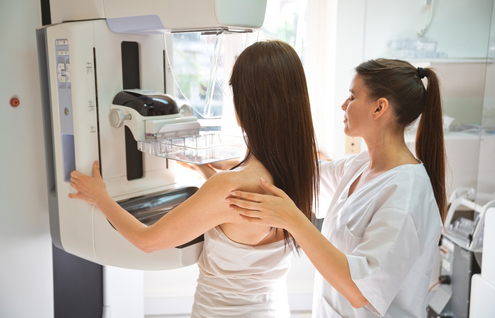
A screening mammogram is an important step in taking care of your health. Mammograms are low-dose x-rays of the breast that help find breast cancer at an early stage, when treatment is most likely to be successful. Finding and treating breast cancer early leads to higher survival rates and, often, an easier course of treatment.
Preparing for your first screening mammogram, like any medical appointment, can be intimidating, according to Melissa Spiezio, breast health navigator at SVMC’s Breast Health & Imaging Center.
“Our team is committed to making every patient feel comfortable and informed,” Spiezio said. “Before the screening, our technologist will explain each step in the process and answer any questions you may have.”
Communicating with your technologist is important. You should inform them of any breast changes or problems you are experiencing, if you have breast implants, if you have trouble standing or holding still unassisted, if you are breastfeeding or if you are or think you might be pregnant.
Spiezio says there are few ways first-time patients can prepare and explains what to expect during your first screening mammogram.
- Avoid applying powders, ointments or creams to your chest area and armpits the day of the exam, because these products can show up on the X-ray images and can make it difficult to interpret. If you wear deodorant, please apply it sparingly, as you will be asked to wipe it off before your mammogram.
- You should avoid wearing any neck jewelry or long earrings. You can also opt to remove those things prior to the mammogram, but leaving it at home ensures nothing will get lost.
- There are no restrictions on eating or drinking prior to your mammogram, so you can follow your normal routine. You can also follow your regular medication schedule.
- You’ll have to undress above the waist to get a mammogram. For this reason, consider wearing a two-piece outfit for ease of bra and shirt removal. You will be given an examination gown to cover up.
- You and the technologist will be the only ones in the room during the mammogram.
- To get a high-quality picture, your breast must be flattened or compressed. You'll stand in front of the machine, and the technologist will place your breast on the machine. The plastic upper plate is then lowered to compress your breast for about 10 to 15 seconds while the technologist takes an x-ray. You will then need to change position so your breast is compressed from side to side before the next x-ray is taken.
- The compression can be uncomfortable and, in some cases, painful. Please communicate your pain and discomfort level to your technologist, so they can adjust the compression. Over-the-counter pain medications, one hour prior to your appointment, can also be helpful if you are concerned about pain. Each position will take 10-15 seconds.
- You will be getting a 3D mammogram (also known as digital breast tomosynthesis, or DBT), and you'll notice that the machine will move in a small arc, either over the top of your breast or along the side of your breast, for each image. You might be asked to hold your breath each time it's being done.
- Typically, two views of each breast are taken for a screening mammogram. For women with breast implants or larger breasts, more pictures may be needed.
The National Breast Cancer Foundation also offers a helpful checklist for preparing for your appointment.
After your mammogram
Your mammogram will be read by a specially-trained radiologists, who will send the results to your physician. You will receive a written summary of the report.
Depending on your results, you may be scheduled for a follow-up diagnostic mammogram. It is more common to get called back after a first mammogram, due to the lack of comparison with previous images.
This will be similar to the screening but involve more pictures, with a focus on the area that looked different on the screening mammogram (or where the symptoms are).
Getting Scheduled
Not sure if you’re due for a mammogram? In addition to speaking with your primary care provider (PCP) or OB-Gyn office, the American Cancer Society explains the latest screening guidelines for those with average risk and high risk of breast cancer.
To be scheduled, you will need referral for a screening mammogram from either your PCP or OB-Gyn.
If you don’t have a PCP, some of SVMC’s Primary Care practices are accepting new patients.
You First
Eligible Vermont residents can benefit from the You First program, covering the cost of breast cancer screenings and diagnostic follow-up.
You First connects Vermonters with a You First team member to help you navigate the health care system—from answering questions, to sending reminders, to scheduling appointments, to arranging transportation, to interpreting results. It also offers healthy lifestyle perks for members 35-64.